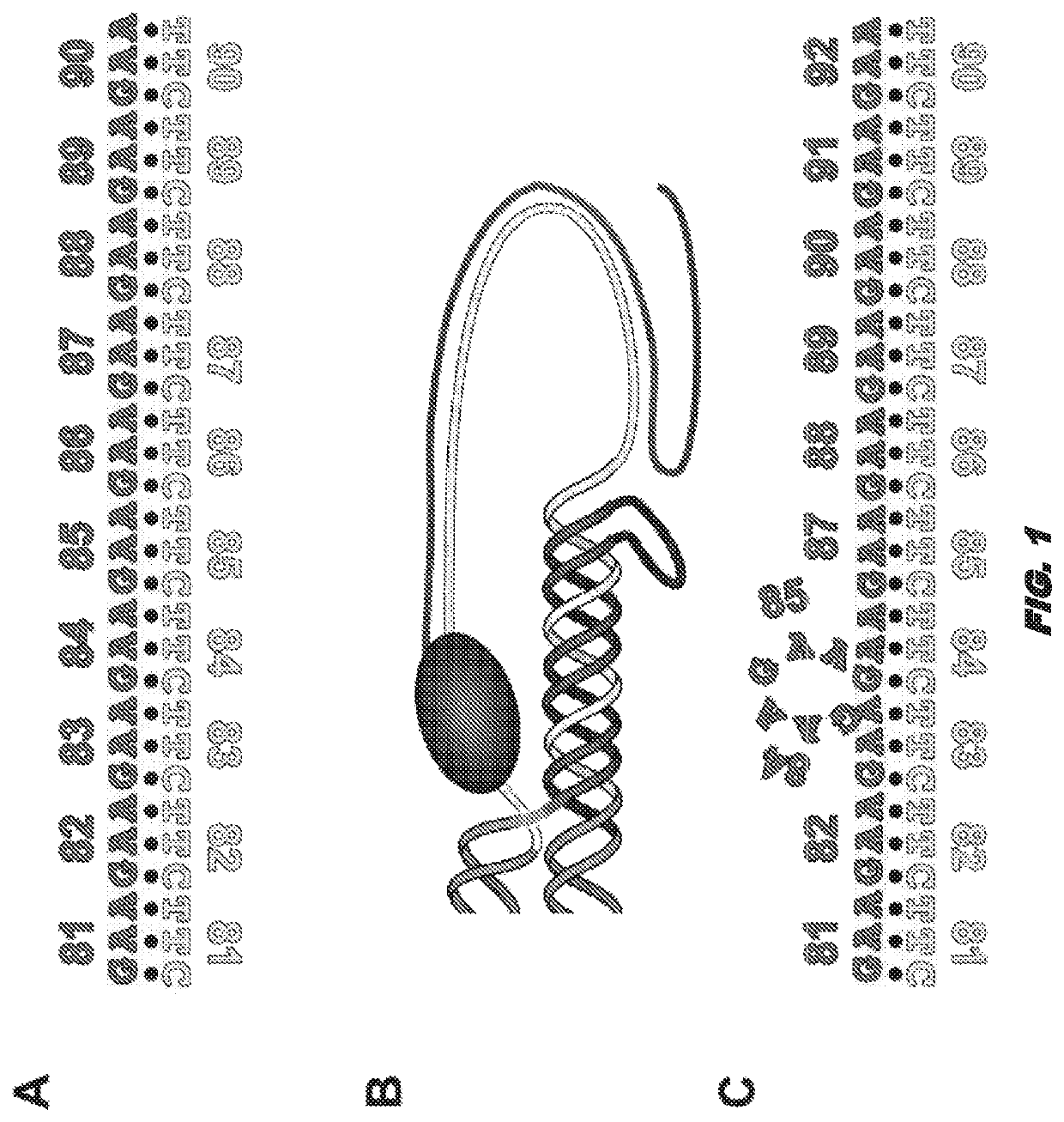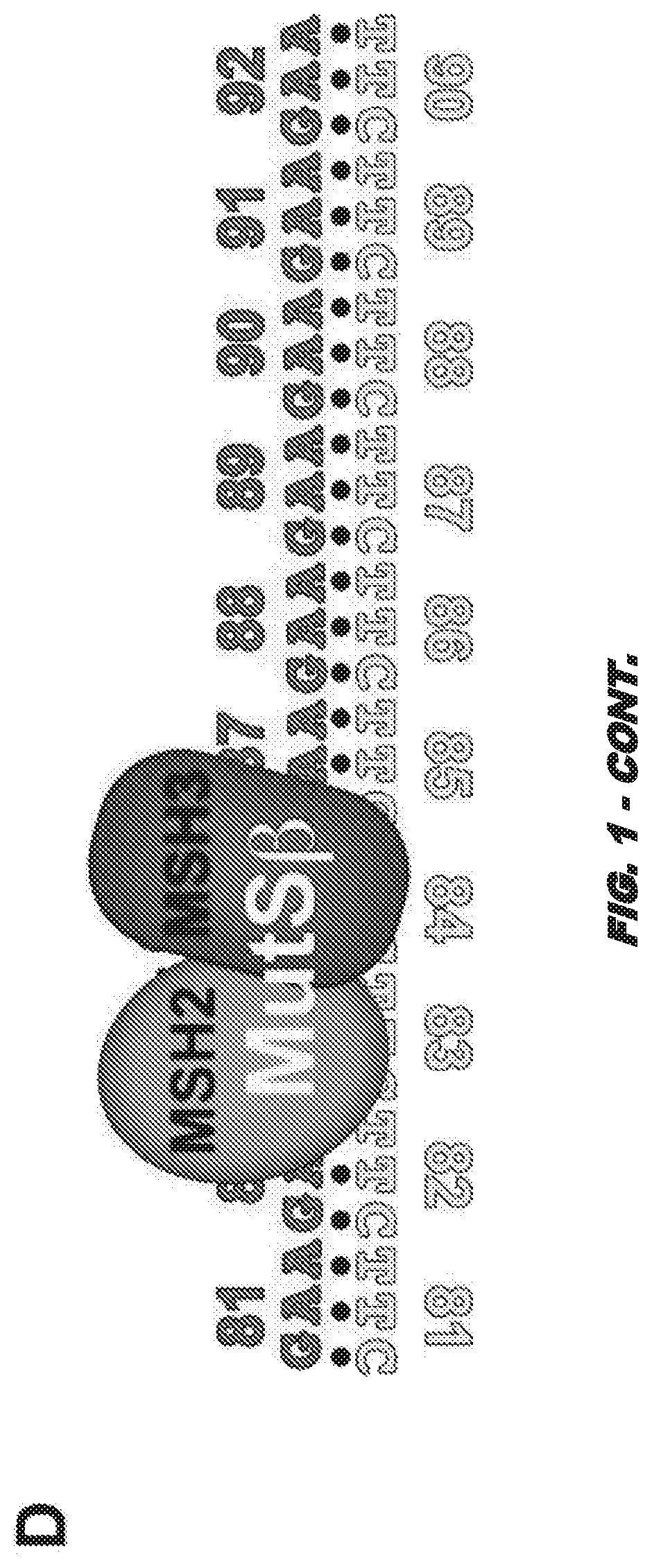Compositions and uses for treatment thereof
a technology of compounding and dna repeat expansion, applied in the field of compounding for the treatment of dna repeat expansion diseases, can solve the problems of mmr actually contributing to genome instability, no treatment, no cure for friedreich ataxia, etc., and achieve the effect of promoting the skipping of region(s) of a gene product and reducing the rate of dna repeat expansion
- Summary
- Abstract
- Description
- Claims
- Application Information
AI Technical Summary
Benefits of technology
Problems solved by technology
Method used
Image
Examples
example 1
Friedreich Ataxia is Characterized by Progressive Repeat Expansion
[0142]Friedreich ataxia (FRDA) is a progressive neurodegenerative disorder caused by GAA⋅TTC repeat expansion in the first intron of the frataxin (FXN) gene (3). Disease severity correlates to the length of the expanded repeats and the consequent reduction of FXN gene expression. While the mechanism of repeat expansion is not yet understood, we have developed versatile human cell models with an integrated “tandem reporter” (15) that recapitulate the expansion seen in FRDA patients that have allowed us to make rapid progress in understanding the expansion process.
[0143]This model has a key advantage over authentic FXN repeat expansion: the repeats are not linked to an essential gene. Thus, the well-known problems associated with selection against frataxin knockdown cells in culture are able to be avoided (16). Further advantages of this system include a single copy genomic location, the ability to control the transcrip...
example 2
[0176]MLH3 expression is key to GAA⋅TTC expansion in human cells and forms the basis for the first therapeutic to slow the expansion rate in Friedreich ataxia and perhaps other repeat expansion diseases. This minor component of mismatch repair (MMR) will be developed as a therapeutic target to limit repeat expansion in FRDA patients. in vivo efficacy and safety studies will be conducted in a mouse model. Without being bound by theory, selective expansion of GAA⋅TTC repeats in disease relevant tissues to a critical size drives disease onset and progression in FRDA. Somatic expansion of GAA⋅TTC repeats requires transcription through the repeat then the sequential actions of MutSβ (MSH2 / MSH3 heterodimer) and MutLγ (MLH1 / MLH3 heterodimer). MSH3 expression was linked to active GAA⋅TTC expansion in FRDA patient primary cells (G1). Similarly, MMR or MSH3 expression has been linked to region specific expansion of CAG⋅CTG repeats in the Huntington's disease (HD) “R6” mouse model (G2-G4). MLH...
example 3
[0225]Monitoring mice for long-term consequences of the treatments described in these examples can be done. The longest experiments will look at 6-month-old mice, well before even a complete knockout from birth would show an effect. Changing the ratio of MLH3 isoforms, not knocking MLH3 out, will be changed. Furthermore, morpholino oligomers are lost or diluted by cell division. Consequently, cells at risk for a cancer phenotype such as intestinal epithelia or lymphoblasts will only transiently be deficient in MLH3 isoform 1.
[0226]In one embodiment, the frataxin deficient phenotype of the Pook mice can be studied at a later stage. The mFXN knockout allele will be bred out to avoid potential interference with repeat expansion by a frataxin deficient phenotype. Here, frataxin replete Tg(FXN)YG22Pook mice will be used solely to examine repeat expansion.
[0227]As discussed in the preceding examples, SSO efficacy will be assayed in two ways: 1) the MLH3 isoform 1 to isoform 2 ratios will ...
PUM
| Property | Measurement | Unit |
|---|---|---|
| length | aaaaa | aaaaa |
| size | aaaaa | aaaaa |
| nucleic acid | aaaaa | aaaaa |
Abstract
Description
Claims
Application Information
 Login to View More
Login to View More - R&D Engineer
- R&D Manager
- IP Professional
- Industry Leading Data Capabilities
- Powerful AI technology
- Patent DNA Extraction
Browse by: Latest US Patents, China's latest patents, Technical Efficacy Thesaurus, Application Domain, Technology Topic, Popular Technical Reports.
© 2024 PatSnap. All rights reserved.Legal|Privacy policy|Modern Slavery Act Transparency Statement|Sitemap|About US| Contact US: help@patsnap.com










